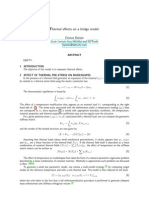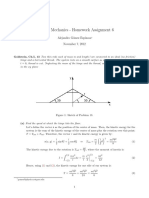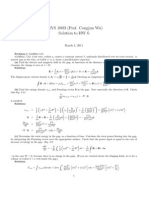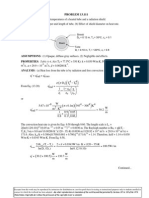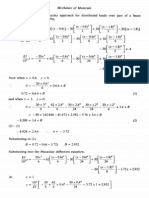0 ratings0% found this document useful (0 votes)
42 views12 - Page 140 PDF
12 - Page 140 PDF
Uploaded by
vik03223The document discusses the deflection of a built-in beam subjected to both bending and a thermal gradient. The differential equation for such a beam is derived by combining the equations for applied bending moment and thermal effects. In the special case of no applied loads, the differential equation reduces to d2Y/dx2 = EIa(T2 - T1)/dx, where T2 is the temperature on the upper surface and T1 is the temperature on the lower surface. Integrating this equation with the boundary condition that the slope is zero at x=0 gives the deflection of the beam at its end.
Copyright:
Attribution Non-Commercial (BY-NC)
Available Formats
Download as PDF, TXT or read online from Scribd
12 - Page 140 PDF
12 - Page 140 PDF
Uploaded by
vik032230 ratings0% found this document useful (0 votes)
42 views1 pageThe document discusses the deflection of a built-in beam subjected to both bending and a thermal gradient. The differential equation for such a beam is derived by combining the equations for applied bending moment and thermal effects. In the special case of no applied loads, the differential equation reduces to d2Y/dx2 = EIa(T2 - T1)/dx, where T2 is the temperature on the upper surface and T1 is the temperature on the lower surface. Integrating this equation with the boundary condition that the slope is zero at x=0 gives the deflection of the beam at its end.
Original Title
12 - Page 140.pdf
Copyright
© Attribution Non-Commercial (BY-NC)
Available Formats
PDF, TXT or read online from Scribd
Share this document
Did you find this document useful?
Is this content inappropriate?
The document discusses the deflection of a built-in beam subjected to both bending and a thermal gradient. The differential equation for such a beam is derived by combining the equations for applied bending moment and thermal effects. In the special case of no applied loads, the differential equation reduces to d2Y/dx2 = EIa(T2 - T1)/dx, where T2 is the temperature on the upper surface and T1 is the temperature on the lower surface. Integrating this equation with the boundary condition that the slope is zero at x=0 gives the deflection of the beam at its end.
Copyright:
Attribution Non-Commercial (BY-NC)
Available Formats
Download as PDF, TXT or read online from Scribd
Download as pdf or txt
0 ratings0% found this document useful (0 votes)
42 views1 page12 - Page 140 PDF
12 - Page 140 PDF
Uploaded by
vik03223The document discusses the deflection of a built-in beam subjected to both bending and a thermal gradient. The differential equation for such a beam is derived by combining the equations for applied bending moment and thermal effects. In the special case of no applied loads, the differential equation reduces to d2Y/dx2 = EIa(T2 - T1)/dx, where T2 is the temperature on the upper surface and T1 is the temperature on the lower surface. Integrating this equation with the boundary condition that the slope is zero at x=0 gives the deflection of the beam at its end.
Copyright:
Attribution Non-Commercial (BY-NC)
Available Formats
Download as PDF, TXT or read online from Scribd
Download as pdf or txt
You are on page 1of 1
122
and, since y
= 0 at
Mechanics o f Materials
55.13
x = 0, then C , = 0, and:
At the end of the cantilever, therefore, the deflection is:
(5.34)
Application to built-in beams
Fig. 5.34. Built-in beam subjected to thermal gradient with temperature TI on the upper surface, T, on the lower surface.
Consider the built-in beam shown in Fig. 5.34. Using the principle of superposition the differential equation for the beam is given by the combination of the equations for applied bending moment and thermal effects. For bending E l -d=2Y
dx2
MA+ RAx.
For thermal effects 7 =
d2Y dx
a(T2 -T1)
..
d 2Y = EI a(T2 -TJ EIdx2 d
... The combined differential equation is:
However, in the absence of applied loads and from symmetry of the beam: and
RA= R g = 0 , MA= M g = M .
..
Integrating: Now at x = 0, - = 0 .'.
d 2Y = M + E I a(T2 --Td EIdx2 d
dY dx
c, = 0,
(5.35)
You might also like
- Sheet2 SolvedDocument25 pagesSheet2 Solvedirshad224No ratings yet
- FINITE ELEMENT METHODS - Model PaperDocument3 pagesFINITE ELEMENT METHODS - Model PaperUpendra NeravatiNo ratings yet
- Modeling and Simulating of Gas Turbine Cooled Blades: А. Pashayev, D. Askerov, R. Sadiqov, A. Samedov, and C. ArdilDocument6 pagesModeling and Simulating of Gas Turbine Cooled Blades: А. Pashayev, D. Askerov, R. Sadiqov, A. Samedov, and C. ArdilganimechNo ratings yet
- Applications Diffrntl EqnsDocument20 pagesApplications Diffrntl EqnsMujeeb AbdullahNo ratings yet
- Thermal Effects On A Bridge ModelDocument3 pagesThermal Effects On A Bridge ModelRick Milton Delgadillo AyalaNo ratings yet
- Exercise 26:: ∆ l=1 mω l AY m, A Y ∆ l ∝ωDocument21 pagesExercise 26:: ∆ l=1 mω l AY m, A Y ∆ l ∝ωAbhishek PathakNo ratings yet
- Temperature and Thermal Stresses Distributions in A Dry Friction ClutchDocument10 pagesTemperature and Thermal Stresses Distributions in A Dry Friction ClutchOday IbraheemNo ratings yet
- Homework 6 PDFDocument6 pagesHomework 6 PDFFlor Hernandez Tiscareño100% (1)
- 12.3 Example Problems: φ (x M JG dxDocument1 page12.3 Example Problems: φ (x M JG dxmanmathkNo ratings yet
- 10 02 Parabolic PDE IntroDocument26 pages10 02 Parabolic PDE IntroJohn Bofarull GuixNo ratings yet
- Heat Transfer ProblemDocument28 pagesHeat Transfer ProblemRahul BajakNo ratings yet
- hw2 SolDocument6 pageshw2 Sollrodriguez_892566No ratings yet
- 0022 - Circle Surface With Thermal Loading: DescriptionDocument4 pages0022 - Circle Surface With Thermal Loading: DescriptionGicuNo ratings yet
- FEM Question BankDocument13 pagesFEM Question BankmanisekNo ratings yet
- 3 International Physics Olympiad 1969, Brno, Czechoslovakia: BandcofmassesmDocument9 pages3 International Physics Olympiad 1969, Brno, Czechoslovakia: BandcofmassesmJoseph TrujilloNo ratings yet
- Examples - PhysicsDocument8 pagesExamples - Physicslaila1001No ratings yet
- Solution Tutorial 2 2020Document14 pagesSolution Tutorial 2 2020zacharyNo ratings yet
- D 2 y M - EX: Slope and Dejection of BeamsDocument1 pageD 2 y M - EX: Slope and Dejection of Beamsvik03223No ratings yet
- sm2 53 PDFDocument3 pagessm2 53 PDFBrain Choirul IchsanNo ratings yet
- If Blocks D and F Each Have Weight W, Determine The Weight of Block E If The Sag Is S. Neglect The Size of The PulleysDocument32 pagesIf Blocks D and F Each Have Weight W, Determine The Weight of Block E If The Sag Is S. Neglect The Size of The PulleysXisco GonzalezNo ratings yet
- Polytechnic University of Puerto Rico ME 4130Document7 pagesPolytechnic University of Puerto Rico ME 4130dannyyukaNo ratings yet
- Physics 121.6 2007/2008: Assignment 4 - SolutionsDocument8 pagesPhysics 121.6 2007/2008: Assignment 4 - SolutionsLuwakCoffeenya YHogiNo ratings yet
- Faculty of Electrical and Electronic Engineering 2020 - 2021Document8 pagesFaculty of Electrical and Electronic Engineering 2020 - 2021Thinh LêNo ratings yet
- sm3 3Document1 pagesm3 3jrhowell2323No ratings yet
- S S S 3 Fur Maths 2ND Term E-Note 2017Document31 pagesS S S 3 Fur Maths 2ND Term E-Note 2017Gabriel OnalekeNo ratings yet
- Sample Lab 2Document7 pagesSample Lab 2Febri SSNo ratings yet
- Some SolutionsDocument4 pagesSome SolutionsMinh BéoNo ratings yet
- Me6603 Fea Rejinpaul Iq Am19Document5 pagesMe6603 Fea Rejinpaul Iq Am19shivesh rockesNo ratings yet
- Work Ower EnergyDocument31 pagesWork Ower EnergyOmprakash Dhaka100% (2)
- Sample Problems From Solving Dynamics Problems in Mathcad: by Brian D. Harper Ohio State UniversityDocument9 pagesSample Problems From Solving Dynamics Problems in Mathcad: by Brian D. Harper Ohio State UniversityMario Jucharo LaymeNo ratings yet
- HW09 - StaticsDocument6 pagesHW09 - StaticsBradley NartowtNo ratings yet
- HW09 - Angular Momentum Conservation and GravitationDocument8 pagesHW09 - Angular Momentum Conservation and GravitationBradley NartowtNo ratings yet
- Publication 12 15586 1695Document5 pagesPublication 12 15586 1695valmeidaNo ratings yet
- Finite Element Heat Transfer EquationsDocument8 pagesFinite Element Heat Transfer EquationsRicox4444No ratings yet
- ch2 108 111Document6 pagesch2 108 111Gonçalo CruzeiroNo ratings yet
- Thermal Equivalent Calcn of Short Circuit CurrentDocument12 pagesThermal Equivalent Calcn of Short Circuit CurrentAnonymous yD6Qpiq3No ratings yet
- AdvHeatMass L 26 PDFDocument7 pagesAdvHeatMass L 26 PDFShanmukShannuNo ratings yet
- 9277Document11 pages9277Khalid HameedNo ratings yet
- Equilibrium in 3D NewDocument32 pagesEquilibrium in 3D NewTuhafeni HailekaNo ratings yet
- Example: Given: A 0.5 KG Ball of Negligible SizeDocument9 pagesExample: Given: A 0.5 KG Ball of Negligible SizegNo ratings yet
- HW6 SolDocument17 pagesHW6 SolAnonymous Zz1bV7H59yNo ratings yet
- Advance 20Document12 pagesAdvance 20Phantom1699No ratings yet
- Cutting Effort Mechanical Engineering Desing Exercise 3.71 Shigley, Ninth EditionDocument6 pagesCutting Effort Mechanical Engineering Desing Exercise 3.71 Shigley, Ninth EditionMiguel Angel Pulido QuezadaNo ratings yet
- Accuracy of Temperature Estimates Using Transfer CoefficientsDocument12 pagesAccuracy of Temperature Estimates Using Transfer CoefficientsMuhammad Fakhri AzizNo ratings yet
- M Ulti-Dimensional ConductionDocument10 pagesM Ulti-Dimensional ConductionMustafa Çağlar BekerNo ratings yet
- Engineering Mechanics - Dynamics - 9780495295617 - Exercise 19 - QuizletDocument5 pagesEngineering Mechanics - Dynamics - 9780495295617 - Exercise 19 - QuizletAmirali SahebzamaniNo ratings yet
- JB Ruz Zo Homework 1Document2 pagesJB Ruz Zo Homework 1John BruzzoNo ratings yet
- sm13 111Document2 pagessm13 111Timothy JonesNo ratings yet
- Fisica 5 PRDocument11 pagesFisica 5 PRCarlosNo ratings yet
- Dynamics ReviewerDocument25 pagesDynamics ReviewerJiyu0% (1)
- Engineering Mechanics - Part29 PDFDocument9 pagesEngineering Mechanics - Part29 PDFBeatrize Espiritu VallesteroNo ratings yet
- Cae Assignment 2Document2 pagesCae Assignment 2Keefwat TawfeekNo ratings yet
- Energy Elastic Strain EnergyDocument14 pagesEnergy Elastic Strain EnergyamirwmNo ratings yet
- FEM Project Report Group13Document16 pagesFEM Project Report Group13nimishk92No ratings yet
- HW 2 SolutionDocument5 pagesHW 2 SolutionSSNo ratings yet
- PHY 1203 Revision-Test 2Document9 pagesPHY 1203 Revision-Test 2combtmpijk47No ratings yet
- 116 Mechanics Materials g5.11Document1 page116 Mechanics Materials g5.11vik03223No ratings yet
- Slope and Defection of Beams: KN 2 0 K N KNDocument1 pageSlope and Defection of Beams: KN 2 0 K N KNvik03223No ratings yet
- D2y dx2 Dy: Mechanics of MaterialsDocument1 pageD2y dx2 Dy: Mechanics of Materialsvik03223No ratings yet
- D 2 y M - EX: Slope and Dejection of BeamsDocument1 pageD 2 y M - EX: Slope and Dejection of Beamsvik03223No ratings yet
- 12 - Page 137 PDFDocument1 page12 - Page 137 PDFvik03223No ratings yet
- Mechanics: 5.8. Principle of SuperpositionDocument1 pageMechanics: 5.8. Principle of Superpositionvik03223No ratings yet
- 5.7 Slope and Deflection of Beams: (C) Simply Supported Beam With U.D.LDocument1 page5.7 Slope and Deflection of Beams: (C) Simply Supported Beam With U.D.Lvik03223No ratings yet
- Slope and Dejection Of: X X X Dy DX X Dy DXDocument1 pageSlope and Dejection Of: X X X Dy DX X Dy DXvik03223No ratings yet
- Slope and Defection of Beams: Fig. 5.24. Maxwell's Theorem of Reciprocal DisplacementsDocument1 pageSlope and Defection of Beams: Fig. 5.24. Maxwell's Theorem of Reciprocal Displacementsvik03223No ratings yet
- 12 - Page 138 PDFDocument1 page12 - Page 138 PDFvik03223No ratings yet
- 12 - Page 136 PDFDocument1 page12 - Page 136 PDFvik03223No ratings yet
- Fig. 4.14. Eccentric Loading of Rectangular Sections-"Middle Third"Document1 pageFig. 4.14. Eccentric Loading of Rectangular Sections-"Middle Third"vik03223No ratings yet
- Mechanics of Materials: ProblemsDocument1 pageMechanics of Materials: Problemsvik03223No ratings yet
- Slope Deflection of Beams: (A) Deflection Positive UpwardsDocument1 pageSlope Deflection of Beams: (A) Deflection Positive Upwardsvik03223No ratings yet
- Mechanics Materials Solution: X X X X XDocument1 pageMechanics Materials Solution: X X X X Xvik03223No ratings yet
- 12 - Page 122 PDFDocument1 page12 - Page 122 PDFvik03223No ratings yet
- Lo6 Io: Mechanics of MaterialsDocument1 pageLo6 Io: Mechanics of Materialsvik03223No ratings yet
- 5.7. Mohr's "Area-Moment" Method: B.M. DiagramDocument1 page5.7. Mohr's "Area-Moment" Method: B.M. Diagramvik03223No ratings yet
- 12 - Page 96 PDFDocument1 page12 - Page 96 PDFvik03223No ratings yet
- Slope Deflection of Beams: y (Or Dy DX D 2 y EI dx2 D 3 y EI-dx3 D4y EI - dx4Document1 pageSlope Deflection of Beams: y (Or Dy DX D 2 y EI dx2 D 3 y EI-dx3 D4y EI - dx4vik03223No ratings yet
- 12 - Page 109 PDFDocument1 page12 - Page 109 PDFvik03223No ratings yet
- Mechanics of Materials: or orDocument1 pageMechanics of Materials: or orvik03223No ratings yet
- 12 - Page 125Document1 page12 - Page 125vik03223No ratings yet
- 12 - Page 128 PDFDocument1 page12 - Page 128 PDFvik03223No ratings yet
- 5.1 Continuous Beams-Clapeyron's "Three-Moment" Equation: Slope and Deflection BeamsDocument1 page5.1 Continuous Beams-Clapeyron's "Three-Moment" Equation: Slope and Deflection Beamsvik03223No ratings yet
- Sbpe Ot: A Wirh Moment WithDocument1 pageSbpe Ot: A Wirh Moment Withvik03223No ratings yet
- 85.1 Slope and Deflection of Beams 6x: l/EZ 1/EZDocument1 page85.1 Slope and Deflection of Beams 6x: l/EZ 1/EZvik03223No ratings yet
- Mechanics of Materials (D) Simply Supported Beam Central Concentrated LoadDocument1 pageMechanics of Materials (D) Simply Supported Beam Central Concentrated Loadvik03223No ratings yet
- Slope Deflection Beams 6 A% L: and ofDocument1 pageSlope Deflection Beams 6 A% L: and ofvik03223No ratings yet
- 12 - Page 113 PDFDocument1 page12 - Page 113 PDFvik03223No ratings yet





